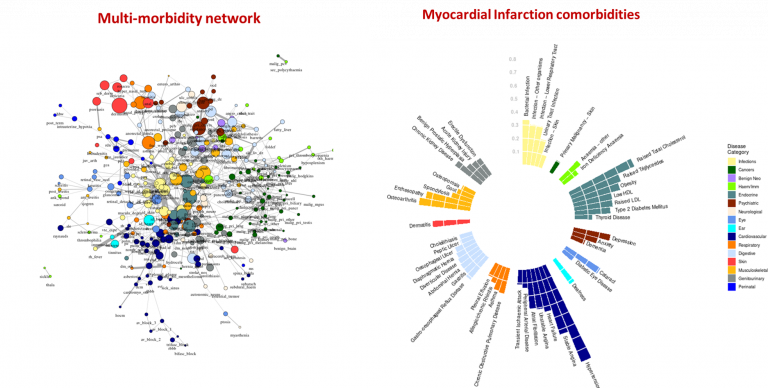New paper: Identifying and visualising multimorbidity and comorbidity patterns in NHS patients
30 November 2022
The Multimorbidity Mechanism and Therapeutic Research Collaborative (MMTRC) publish on multimorbidity and comorbidity patterns in Lancet Digital Health.

Researchers start to investigate how and why individuals develop multiple diseases as they get older.
Medical education and training, healthcare delivery, clinical guidelines and research have evolved to focus on one disease area at a time.
Yet, with advancing age, millions of people live with multiple conditions -- sometimes referred to as multimorbidity -- and the proportion of people affected in this way is expected to rise over the next decades. People from less advantaged groups may be disproportionately affected.
The Academy of Medical Sciences and the UK Chief Medical Officer (CMO) have recognised this problem and set out a challenge to investigate which diseases co-occur in the same individuals and why.
Identifying diseases that cluster in the same individuals, regardless of cause, could help more efficiently organise education, training, and service provision to better meet the needs of the growing number of patients with multimorbidity
Identifying diseases that cluster more commonly than expected by chance could also help discover mechanisms that are common to multiple diseases; to identify shared risk factors; and identify opportunities to develop new or use existing medicines to treat several conditions together.
In Lancet Digital Health, Kuan and colleagues from the Multimorbidity Mechanism and Therapeutics Research Collaborative, have harnessed the opportunity provided by the National Health Service, which provides universal healthcare throughout life to millions of UK citizens, to address the challenge set out by the Academy and CMO.
Using information from routine health record data from primary and secondary care from around 4 million patients in England, the authors systematically identify the patterns of clustering of 308 common mental and physical health conditions at different ages, in men and women, and in people of different ethnicity.
As illustrative examples, heart failure often co-occurred with hypertension, atrial fibrillation, osteoarthritis, stable angina, myocardial infarction, chronic kidney disease, type 2 diabetes, and chronic obstructive pulmonary disease. Hypertension was most strongly associated with kidney disorders in those aged 20–29 years, but with dyslipidaemia, obesity, and type 2 diabetes in individuals aged 40 years and older. Breast cancer was associated with different comorbidities in individuals from different ethnicities; asthma with different comorbidities between the sexes; and bipolar disorder with different comorbidities in younger ages compared with older ages.
The authors developed accessible tools to help users visualise patterns of disease co-occurrence including for diseases that cluster more commonly than expected by chance, providing an entry point to investigate common risk factors and treatments.
The findings from this research should help patients better understand their illnesses, doctors better plan management of patients with multimorbidity, healthcare providers optimise service delivery, policy makers plan resource allocation, and researchers to develop new or use existing medicines to treat several diseases together.
The research was enabled by the UK Research and Innovation (UKRI) Strategic Priority Fund “Tackling multimorbidity at scale” programme (grant number MR/V033867/1) delivered by the Medical Research Council and the NIHR in partnership with the Economic and Social Research Council and in collaboration with the Engineering and Physical Sciences Research Council. Additional funding came from the UCL Hospitals NIHR Biomedical Research Centre, Wellcome Trust, British Heart Foundation, Rosetrees Trust and The Alan Turing Institute.
References
The Academy of Medical Sciences. Multiple long-term conditions (multimorbidity): a priority for global health research. 2018. https://acmedsci.ac.uk/policy/policy-projects/multimorbidity (accessed June 11, 2022).
Whitty CJM, Watt FM. Map clusters of diseases to tackle multimorbidity. Nature 2020; 579: 494–96.
 Close
Close

